The September 11 attacks of 2001, in addition to being a unique act of terrorism, constituted a media event on a scale not seen since the advent of civilian global satellite links. Instant worldwide reaction and debate were made possible by round-the-clock television news organizations and by the internet. As a result, most of the events listed below were known by a large portion of the world's population as they occurred.

Stairs are a structure designed to bridge a large vertical distance between lower and higher levels by dividing it into smaller vertical distances. This is achieved as a diagonal series of horizontal platforms called steps which enable passage to the other level by stepping from one to another step in turn. Steps are very typically rectangular. Stairs may be straight, round, or may consist of two or more straight pieces connected at angles.

The collapse of the World Trade Center occurred on Tuesday, September 11, 2001, after two commercial airliners hijacked by Al-Qaeda terrorists were deliberately flown into the Twin Towers of the World Trade Center complex in New York City as part of the September 11 attacks. The North Tower was the first building to be hit when American Airlines Flight 11 crashed into it at 8:46 a.m., causing it to collapse at 10:28 after burning for one hour and 42 minutes. At 9:03 a.m., the South Tower was struck by United Airlines Flight 175; it collapsed at 9:59 a.m. after burning for 56 minutes. The towers' destruction caused major devastation throughout Lower Manhattan, and more than a dozen adjacent and nearby structures were damaged or destroyed by debris from the plane impacts or the collapses. Four of the five remaining World Trade Center structures were immediately crushed or damaged beyond repair as the towers fell, while 7 World Trade Center remained standing for another six hours until fires ignited by raining debris from the North Tower brought it down at 5:21 that afternoon. The hijackings, crashes, fires and subsequent collapses killed an initial total of 2,760 people. Toxic powder from the demolished high-rises was dispersed throughout the city and gave rise to numerous long-term health effects that continue to plague many who were in the towers' vicinity, with at least three additional deaths reported. The 110-story towers are the tallest freestanding structures ever to be destroyed, and the death toll from the attack on the North Tower represents the deadliest terrorist act in world history.

The Marriott World Trade Center was a 22-story, 825-room hotel at 3 World Trade Center within the World Trade Center complex in Manhattan, New York City. It opened in April 1981 as the Vista International Hotel and was the first major hotel to open in Lower Manhattan south of Canal Street since 1836. It was also known as World Trade Center 3, the World Trade Center Hotel, the Vista Hotel, and the Marriott Hotel throughout its history.
Brian Clark is a Canadian businessman and survivor of the attacks on the World Trade Center on September 11, 2001. Clark worked for the American international brokerage firm Euro Brokers Inc., which lost 61 employees that day, nearly one-fifth of its New York branch.

Jules Clément Naudet and brother Thomas Gédéon Naudet are French-American filmmakers. The brothers, residents of the United States since 1989 and citizens since 1999, were in New York City at the time of the September 11 attacks to film a documentary on members of the Engine 7, Ladder 1 firehouse in Lower Manhattan.

Cyril Richard Rescorla was a British-American soldier, police officer, educator and private security specialist. He served as a British Army paratrooper during the Cyprus Emergency and a commissioned officer in the United States Army during the Vietnam War. He rose to the rank of colonel in the Army before entering the private sector, where he worked in corporate security.
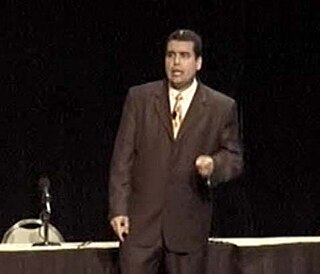
William Rodríguez is a former janitor at the North Tower of the World Trade Center during the September 11, 2001, attacks and was in the basement of the North Tower when American Airlines Flight 11 crashed into the building. After the attacks he received several awards for heroism for helping in the evacuation of many survivors. The Birmingham Mail said about Rodriguez: "He bravely led firefighters up the stairs, unlocking doors as they climbed and helping hundreds of survivors" and The Lancashire Telegraph added: "He then went back into the building in a bid to rescue his friends at the top of the tower, on the 106th floor. But he kept finding others who needed his help as well."

One World Trade Center, also known as One World Trade, One WTC, and formerly called the Freedom Tower during initial planning stages, is the main building of the rebuilt World Trade Center complex in Lower Manhattan, New York City. Designed by David Childs of Skidmore, Owings & Merrill, One World Trade Center is the tallest building in the United States, the tallest building in the Western Hemisphere, and the seventh-tallest in the world. The supertall structure has the same name as the North Tower of the original World Trade Center, which was destroyed in the terrorist attacks of September 11, 2001. The new skyscraper stands on the northwest corner of the 16-acre (6.5 ha) World Trade Center site, on the site of the original 6 World Trade Center. It is bounded by West Street to the west, Vesey Street to the north, Fulton Street to the south, and Washington Street to the east.
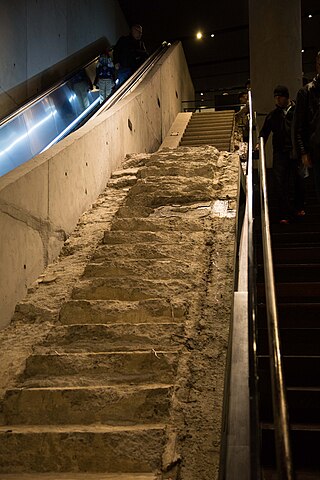
The Survivors' Staircase was the last visible remaining original structure above ground level at the World Trade Center site. It was originally an outdoor flight of granite-clad stairs and two escalators which connected Vesey Street to the World Trade Center's Austin J. Tobin Plaza. During the September 11 attacks, the stairs served as an escape route for hundreds of evacuees from 5 World Trade Center, a 9-floor building adjacent to the Twin Towers. The staircase is now an important feature of the National September 11 Memorial & Museum.
9/11: The Twin Towers is a movie based on the 9/11 attacks which uses re-enactments and computer-generated imagery to re-create a minute-by-minute account of what happened inside the twin towers of the World Trade Center in New York City during the September 11 attacks. In the United States it premiered on the Discovery Channel on 3 September 2006, narrated by Harry Pritchett. In the United Kingdom it premiered on BBC One on 7 September 2006, narrated by Terence Stamp.
Alicia Esteve Head is a Spanish businesswoman who claimed to be a survivor of the attacks on the World Trade Center on September 11, 2001, under the name Tania Head. She joined the World Trade Center Survivors' Network support group, later becoming its president. Her name was regularly mentioned in media reports of the attacks. In 2007, it was revealed Head's story was a hoax; she was not in New York City on September 11, 2001, but in reality was attending classes in her native city, Barcelona.
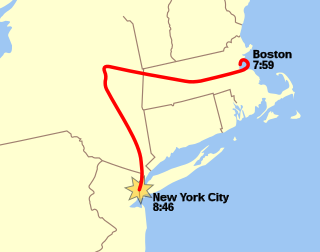
American Airlines Flight 11 was a domestic passenger flight that was hijacked by five al-Qaeda terrorists on the morning of September 11, 2001, as part of the September 11 attacks. The hijacked airliner was deliberately crashed into the North Tower of the World Trade Center complex in New York City, killing everyone aboard the flight and ensuring the deaths of well over a thousand people in the top 18 stories of the skyscraper in addition to causing the demise of numerous others below the trapped floors, making it not only the deadliest of the four suicide attacks executed that morning in terms of both plane and ground fatalities, but also the single deadliest act of terrorism in human history and the deadliest plane crash of all time. The aircraft involved, a Boeing 767-223ER with 92 passengers and crew, was flying American Airlines' daily scheduled morning transcontinental service from Logan International Airport in Boston to Los Angeles International Airport in California.

Welles Remy Crowther was an American equities trader and volunteer firefighter known for saving as many as 18 lives during the September 11 attacks in New York City, during which he lost his own life.
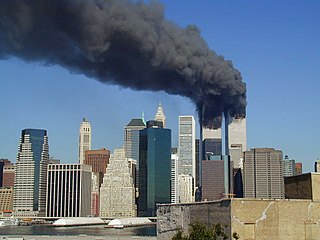
The September 11 attacks of 2001 caused the deaths of 2,996 people, including 2,977 victims and 19 hijackers who committed murder–suicide. Thousands more were injured, and long-term health effects have arisen as a consequence of the attacks. New York City took the brunt of the death toll when the Twin Towers of the World Trade Center complex in Lower Manhattan were attacked, with an estimated 1,600 victims from the North Tower and around a thousand from the South Tower. Two hundred miles southwest in Arlington County, Virginia, another 125 were killed in the Pentagon. The remaining 265 fatalities included the ninety-two passengers and crew of American Airlines Flight 11, the sixty-five aboard United Airlines Flight 175, the sixty-four on American Airlines Flight 77 and the forty-four who boarded United Airlines Flight 93. The attack on the World Trade Center's North Tower single-handedly made 9/11 the deadliest act of terrorism in human history.

2 World Trade Center is a planned skyscraper as part of the World Trade Center complex in Manhattan, New York City. It will replace the original 2 World Trade Center, which was completed in 1972 and subsequently destroyed during the September 11 attacks in 2001, and it will occupy the position of the original 5 World Trade Center. The foundation work was completed in 2013, though no construction has taken place since.

The original World Trade Center (WTC) was a large complex of seven buildings in the Financial District of Lower Manhattan in New York City. It opened on April 4, 1973, and was destroyed during the September 11 terrorist attacks in 2001. At the time of their completion, the Twin Towers—the original 1 World Trade Center at 1,368 feet (417 m); and 2 World Trade Center at 1,362 feet (415.1 m)—were the tallest buildings in the world. Other buildings in the complex included the Marriott World Trade Center, 4 WTC, 5 WTC, 6 WTC, and 7 WTC. The complex contained 13,400,000 square feet (1,240,000 m2) of office space and, prior to its completion, was projected to accommodate an estimated 130,000 people.

Pablo Ortiz was an American construction superintendent, and former Navy SEAL. He worked for the Port Authority of New York and New Jersey, the organization that managed the World Trade Center, and is credited with playing a central role in rescuing at least 77 people who were trapped in the building's elevators during the September 11 attacks. Survivors describe last seeing him ascending a stairwell to go open more elevators with his friend and colleague Francis "Frank" De Martini.
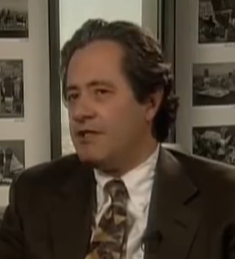
Francis Albert De Martini was an American architect employed by the Port Authority of New York, the agency that managed the World Trade Center, who died in the September 11 attacks in 2001.















